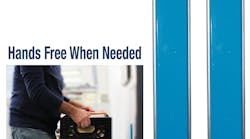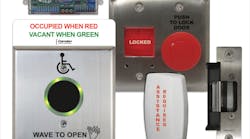Security professionals are often tasked with finding solutions and recommending products to make an entryway more secure. Many times these security recommendations are for hardware upgrade, while other times the recommendations for a more secure entryway are triggered by a breach in security. Hardware manufacturers offer many passive security features for mechanical and electronic locking hardware that provide a more secure entryway. These include:
- High security lock cylinders to deter picking and manipulation
- Hardened cylinder pins and components
- Saw-resistant bolts
- Hardened lock fronts and casings to deter blunt force attacks
While these items protect the lock hardware, they fail to address the connection between the door and jamb. Simple and relatively inexpensive physical security solutions can provide added security to the entryway to deter doorjamb attacks. These include latch protectors and security strikes.
Installation of security strike plates is a passive security feature that is often overlooked. Security strike plates are larger and thicker than traditional strike plates and are designed to provide additional reinforcement around the extended latch or deadbolt on the jamb side of the entryway. Security strikes can also be surface-mounted in order to shrink the gap between the door and the jamb. Security strike plates are a vital component of any passive entryway security plan and help deter forced entry through kick-ins, door prying, jamb spreading, and many other action intended to defeat the lock.
Look for three components when choosing a security strike:
- The area of the strike
- Length of screws used to install the strike
- Position and number of screws used to secure the strike
The area of the security strike plate, or more importantly the length of the strike, is vital in providing added security to the entryway. The added length of a security strike plate provides a metal reinforcement to a softer substance, such as the wood jamb. Where a blunt object, like a screwdriver, can be used to break the wooden jamb, upgrading to a metal security strike plate provides more stability and deters manipulation or forced entry.
The length of the screws used with a security strike plate is most important. Many OEM-supplied strike plates come with screws whose length fastens into the doorjamb. These types of screw do not secure the entryway from a doorjamb attack.
Security strike plates usually provide 3” or longer screws that fasten the security strike plate directly into the stud located behind the jamb. Pro-Lok provides 3” long screws with each security strike. The additional length reduces the chances of the strike plate being dislodged during a doorjamb attack, keeping the integrity of the entryway.
Security strike plates are most effective when the screws anchored into the stud are installed in a staggered patterned versus linear pattern. Staggered entry points provide multiple anchor locations at different positions into the stud, adding to the strength and stability of the security strike plate. The staggered hole pattern should be incorporated into the product by the security strike plate manufacturer. This feature reduces the chances of the security strike plate from being removed by forcible entry.
High Security Box Strikes take security strike plates a step further for an additional level of security. Incorporated in the product design is a steel box, or housing that shelters the bolt or latch when fully extended. This steel housing protects the bolt or latch from forced entry and jamb manipulation by providing an additional metal reinforcement to ensure the integrity of the entryway. Installing a High Security Box Strike will take more time than a traditional security strike plate, but will also increase the billable services provided by the installer.
Entry Armor
In 2010, PRO-LOK launched ENTRY ARMOR, and new brand of security door hardware products build on innovation. The asset- only acquisition of MAG Manufacturing the following year helped PRO-LOK shape the types of products Entry Armor manufactures. The line includes: custom and stock wrap plates and flat plates, latch protectors, strike plates, adaptor plates, holes covers, filler plates, door viewers, patio locks, window locks, and more. Entry Armor also has the capabilities to turn custom jobs around in as little as 1-2 days.
ENTRY ARMOR offers a complete line of Strike Plates, listed in Chart 1. They are manufactured from a steel base, for added security, and finished with a high quality plating process. Available finishes include antique brass, brass, and chrome.
There are many components to a secure passive security plan and there is much more to door security that just the locking hardware. Remember, the other side of door hardware plays a critical role in your plan and the door hardware is only as secure as the strike. These solutions can provide peace of mind to the customer while increasing billable services.
For more information, contact Pro-Lok, 655 North Hariton Street, Orange, CA 92868. Web: PRO-LOK.com. Phone: 714-633-0681.




